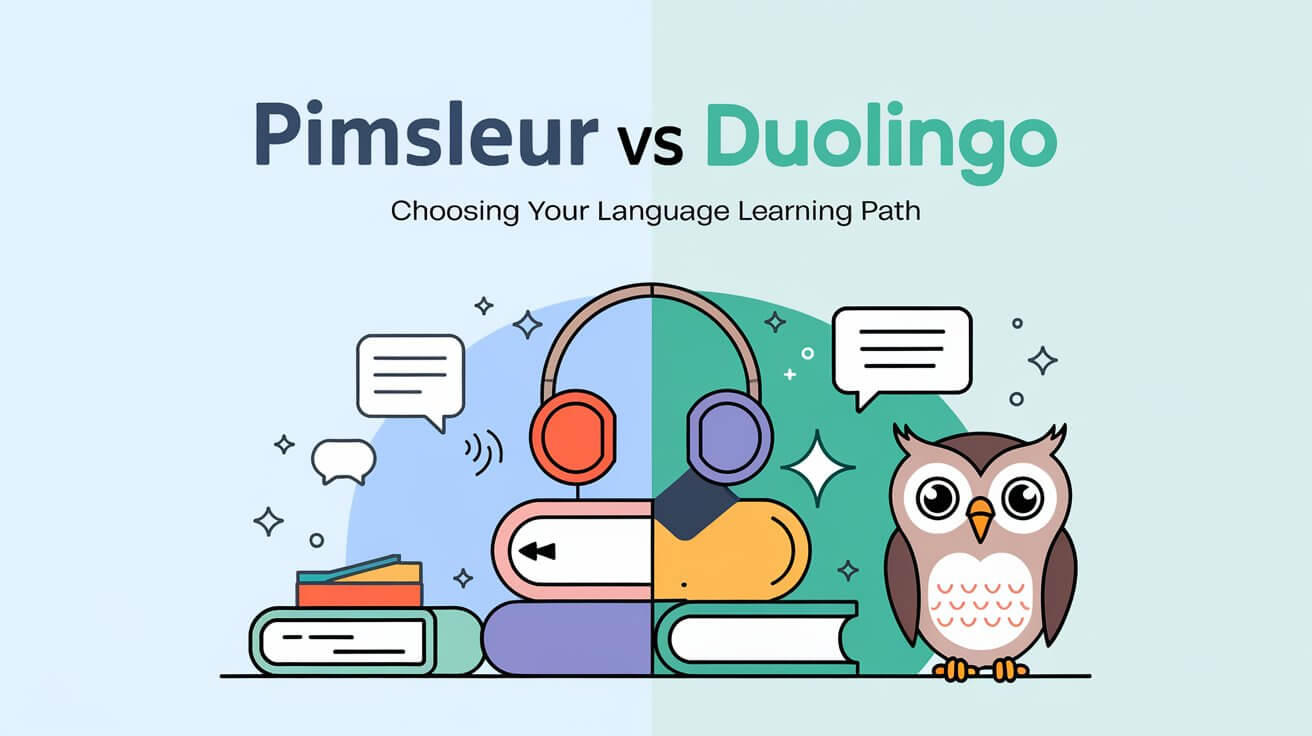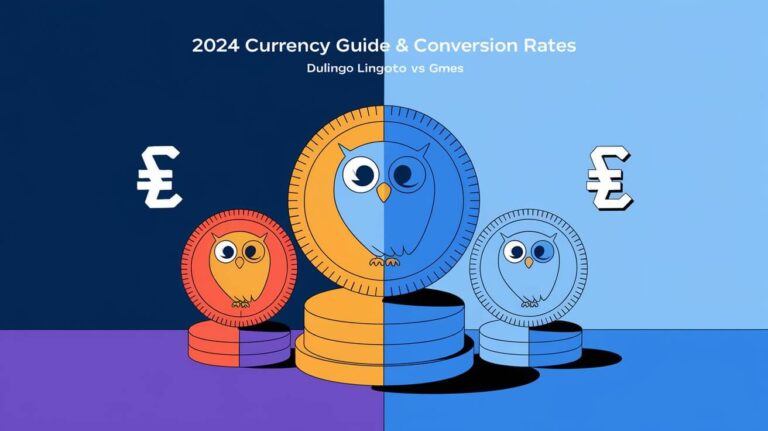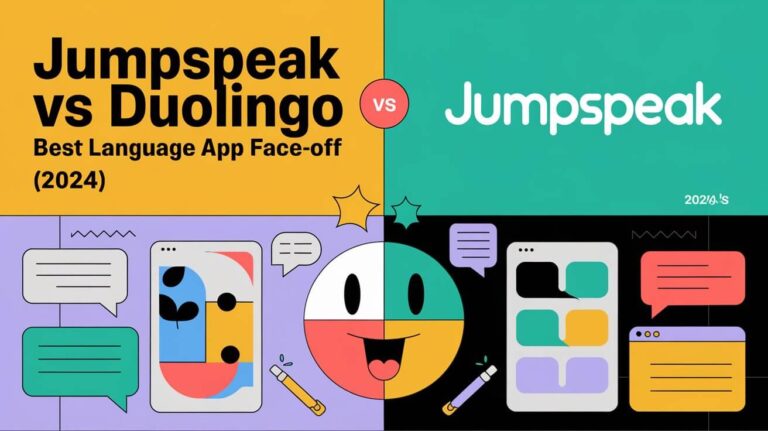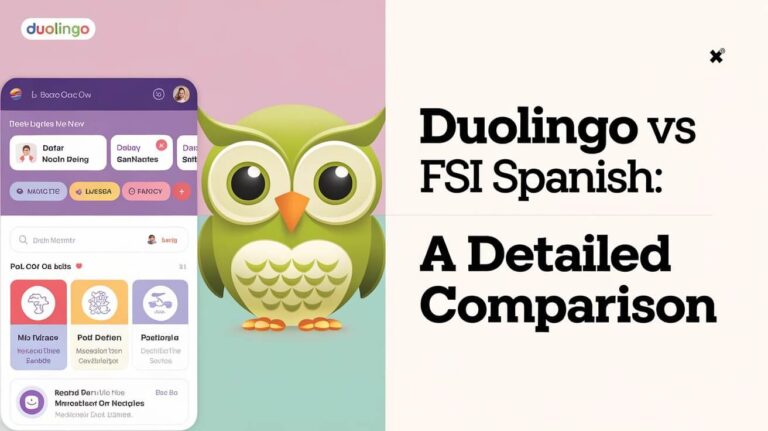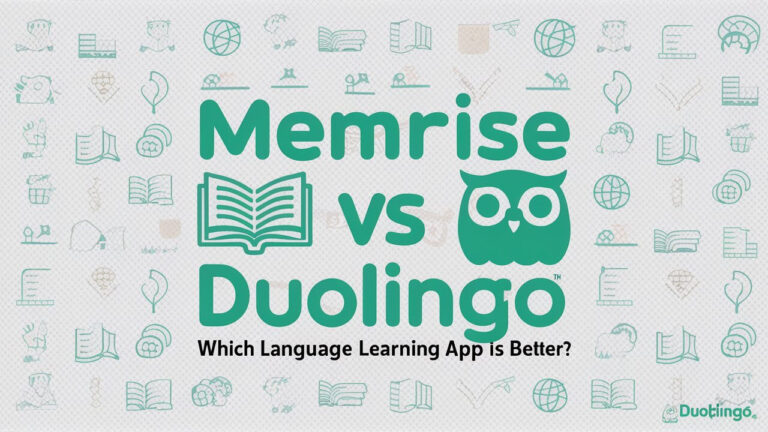Picking the right language app can make or break your learning. Pimsleur and Duolingo stand out among the many choices. Each offers its own style and tools. This guide stacks them up side by side to help you find your perfect fit.
The Basics: Pimsleur and Duolingo Compared
Pimsleur’s Approach to Language Learning
Pimsleur takes an audio-based approach to language learning. It focuses on teaching through listening and speaking. The method, developed by linguist Paul Pimsleur, aims to mimic natural language acquisition.
Pimsleur’s core lessons are 30-minute audio sessions. They guide learners through conversations step-by-step. The program emphasizes practical vocabulary and proper pronunciation. It uses spaced repetition to help information stick in long-term memory.
Duolingo’s Gamified Learning Experience
Duolingo brings a fresh, game-like approach to language learning. It breaks lessons into bite-sized chunks. Users complete short exercises to earn points and virtual currency.
The app covers reading, writing, listening, and speaking skills. It uses a variety of exercise types to keep learners engaged. These include multiple-choice questions, word matching, and sentence translation.
Teaching Methods: Audio-Based vs Gamification
Pimsleur’s Audio-Centric Lessons
Pimsleur’s lessons revolve around audio content. A narrator guides you through conversations in your target language. You’ll listen, repeat, and respond to prompts. This method aims to build speaking confidence quickly.
The audio format allows for multitasking. You can learn while driving, exercising, or doing chores. Pimsleur also includes some reading exercises to reinforce learning.
Duolingo’s Interactive Exercises
Duolingo takes a more varied approach. Its lessons mix different types of exercises. You might translate sentences, match words to pictures, or speak into your device’s microphone.
The app uses gamification to motivate learners. You earn points, unlock levels, and compete with friends. This can make learning feel more like play than work.
Language Options: Breadth vs Depth
Pimsleur’s Language Selection
Pimsleur offers courses in over 50 languages. These range from widely spoken languages like Spanish and Mandarin to less common ones like Ojibwe and Twi.
The depth of content varies by language. Popular languages have up to five levels, while others might have just one or two. Each level contains 30 lessons, providing substantial material for serious learners.
Duolingo’s Language Offerings
Duolingo boasts courses for over 30 languages. Like Pimsleur, it covers major world languages. It also includes constructed languages like Klingon and High Valyrian for fun.
The content depth varies widely between languages. Some courses are extensive, while others are still in development. Duolingo regularly updates and expands its offerings based on user demand.
Pricing: Premium vs Freemium
Pimsleur’s Subscription Model
Pimsleur operates on a subscription-based model. They offer different plans:
- Premium plan: $20/month for one language
- All Access plan: $21/month or $165/year for all languages
Pimsleur provides a 7-day free trial. This lets you test the method before committing. The subscription gives full access to all lessons and features for your chosen language(s).
Duolingo’s Free and Paid Options
Duolingo’s basic version is free. You can learn any language without paying a cent. However, the free version includes ads and has some limitations.
For an ad-free experience and extra features, Duolingo offers Super Duolingo:
- Monthly plan: $12.99/month
- Annual plan: $6.99/month (billed annually)
- Family plan: $9.99/month for up to 6 users
Super Duolingo removes ads, allows offline learning, and provides unlimited hearts (attempts).
Effectiveness: Speaking Skills vs Vocabulary Building
Pimsleur’s Focus on Conversation
Pimsleur excels at developing speaking skills. Its method emphasizes practical conversations from day one. You learn to understand and respond to native speakers quickly.
The program teaches grammar implicitly. You learn sentence structures through repetition and context, not explicit rules. This can lead to more natural-sounding speech.
However, Pimsleur’s vocabulary range is somewhat limited. It focuses on high-frequency words and phrases. This is great for beginners but might not satisfy advanced learners seeking extensive vocabulary.
Duolingo’s Emphasis on Vocabulary and Grammar
Duolingo shines in building vocabulary. Its varied exercises introduce a wide range of words and phrases. The spaced repetition system helps reinforce this vocabulary over time.
The app also teaches grammar more explicitly than Pimsleur. It provides explanations and tips throughout the lessons. This can be helpful for learners who prefer a more structured approach.
Duolingo’s weakness lies in speaking practice. While it includes speaking exercises, they’re less intensive than Pimsleur’s. Some users find they can complete Duolingo courses without gaining much speaking confidence.
User Experience: Traditional vs Modern
Pimsleur’s Structured Approach
Pimsleur offers a straightforward, no-frills experience. The core of the program is audio lessons, supplemented by simple exercises. This can appeal to learners who prefer a focused, distraction-free approach.
The Pimsleur app provides a clean interface for accessing lessons and tracking progress. However, it lacks the bells and whistles of more gamified apps.
Duolingo’s Engaging Interface
Duolingo provides a colorful, engaging user interface. The app is designed to be fun and addictive. Animations, sounds, and achievements keep users motivated.
The learning path is visualized as a skill tree. This gives a clear sense of progress and allows users to choose what to learn next. The variety of exercise types keeps lessons fresh and interesting.
Time Commitment: Long Sessions vs Quick Lessons
Pimsleur’s 30-Minute Lessons
Pimsleur recommends doing one 30-minute lesson per day. This structured approach can help build a consistent learning habit. The longer lesson format allows for more in-depth practice.
The time commitment might be challenging for some learners. However, the audio format makes it possible to fit lessons into a busy schedule by multitasking.
Duolingo’s Bite-Sized Learning
Duolingo’s lessons are much shorter, typically taking 5-10 minutes. This makes it easy to squeeze in practice throughout the day. The app encourages daily use with reminders and streaks.
The shorter format can be great for maintaining motivation. However, it might not provide the depth of practice that longer sessions offer.
Progress Tracking: Linear vs Adaptive
Pimsleur’s Level-Based System
Pimsleur uses a straightforward, level-based system. You progress through numbered lessons in order. This linear approach ensures you build on previous knowledge systematically.
The program doesn’t adapt to individual performance as much as some other apps. However, it does review content at spaced intervals to reinforce learning.
Duolingo’s Skill Tree and XP
Duolingo uses a more complex progress tracking system. You earn experience points (XP) for completing lessons and move up levels. The skill tree shows your progress visually.
The app adapts to your performance, reviewing areas where you struggle. It also uses a “crown” system to indicate mastery of different skills. This can provide a more personalized learning path.
Supplementary Features: Reading vs Stories
Pimsleur’s Reading Lessons
Pimsleur includes reading lessons to complement its audio content. These help learners connect sounds to written words. The reading material ties into the vocabulary and phrases learned in the audio lessons.
While useful, the reading component is not as extensive as the audio lessons. It’s more of a supplement to the core speaking and listening practice.
Duolingo’s Stories and Podcasts
Duolingo offers additional features like Stories and Podcasts for some languages. Stories are short, interactive texts that provide reading practice and teach vocabulary in context.
Duolingo Podcasts combine authentic stories with language learning. They’re available in several languages and provide intermediate learners with engaging content.
Community and Support: Individual vs Social
Pimsleur’s Self-Paced Learning
Pimsleur is designed for individual, self-paced learning. It doesn’t have built-in community features. This can be ideal for learners who prefer to work independently.
The company provides customer support for technical issues. However, there’s less emphasis on peer interaction or community learning.
Duolingo’s Community Features
Duolingo incorporates social elements into its platform. You can add friends, compete on leaderboards, and join clubs. This can provide extra motivation and a sense of community.
The app also has active forums where learners can ask questions and share tips. This social aspect can enhance the learning experience for many users.
The Verdict: Choosing Between Pimsleur and Duolingo
Deciding between Pimsleur and Duolingo depends on your learning style, goals, and preferences. Here’s a quick summary to help you choose:
Choose Pimsleur if:
- You want to focus on speaking and listening skills
- You prefer structured, audio-based learning
- You’re willing to invest in a paid program
- You like longer, more intensive lessons
Choose Duolingo if:
- You want a free option to start learning
- You enjoy game-like, interactive learning
- You prefer short, frequent practice sessions
- You want to learn multiple languages casually
Both Pimsleur and Duolingo have strengths and weaknesses. Pimsleur excels in developing conversational skills, while Duolingo offers a more engaging, varied learning experience.
For serious language learners, using both apps in tandem could be beneficial. Pimsleur could serve as the core program for speaking practice, while Duolingo could supplement with vocabulary and grammar exercises.
Ultimately, the best app is the one you’ll use consistently. Try both and see which motivates you to keep learning. Remember, language learning is a journey, and the right tools can make that journey more enjoyable and successful.

